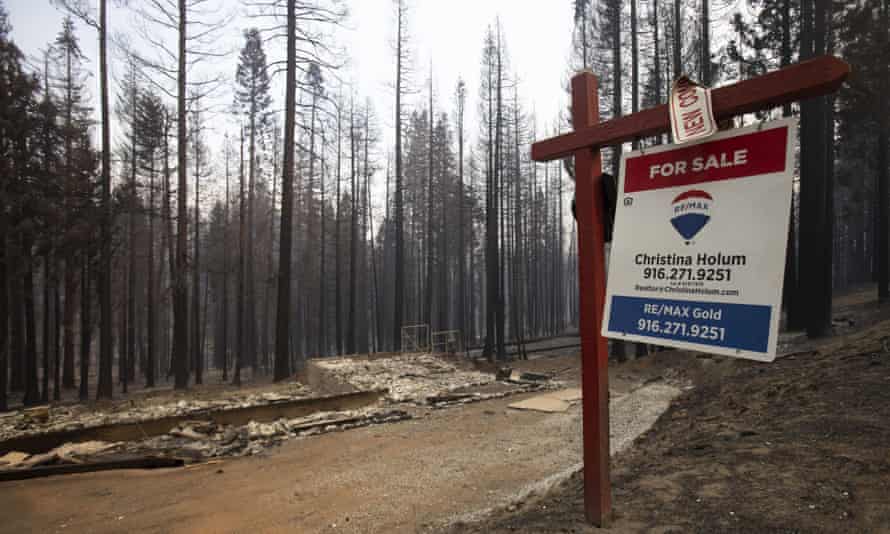Few homes were left standing in Grizzly Flats, California, the small northern California forest town leveled by the Caldor fire on Tuesday.
Streets in the town of about 1,200 people were littered with downed power lines and poles. Houses were reduced to smoldering ash and twisted metal with only chimneys rising above the ruins. A post office and elementary school were also destroyed.
Two people with serious or severe injuries were airlifted to hospitals from the Grizzly Flats area, fire officials said.
The destructions in Grizzly Flats came as dangerously dry and windy weather continued to fuel huge blazes across the American west and prompted the nation’s largest utility to begin shutting off power to tens of thousands customers.
Whipped by the winds, the Caldor fire exhibited extreme behavior as it tore through El Dorado county, trippling in size between Monday and Tuesday afternoon to nearly 50 sq miles (129 sq kilometers). “The fire has grown. It is spreading quickly,” said Chris Vestal, a public information officer on the fire, noting that it had grown so quickly that it was outpacing the department’s ability to document it.

To the north, the Dixie fire, the largest of about 100 active wildfires burning in more than a dozen western states, was advancing toward the town of Susanville, population about 18,000.
The former Sierra Nevada logging and mining town has two state prisons, a nearby federal lockup and a casino. Numerous resources were put into protecting it, said Mark Brunton, an operations section chief. Ash fell from the advancing fire, and a police statement urged residents “to be alert and be ready to evacuate” if the fire threatens the city.
To the east, spot fires burned some structures south of the small community of Janesville, which had been ordered evacuated. But a surge of firefighters was able to herd the fire around the majority of the town, Brunton said.
Meanwhile, the utility Pacific Gas & Electric announced it had begun shutting off power to some 51,000 customers in small portions of 18 northern counties to prevent winds from knocking down or fouling power lines and sparking new blazes.
The utility said the precautionary shutoffs were focused in the Sierra Nevada foothills, the North Coast, the North Valley and the North Bay mountains and could last into Wednesday afternoon.
Near the Caldor fire, Derek Shaves and Tracy Jackson were helping their friend salvage food and other supplies from the Grizzly Pub & Grub, a business in the evacuation zone that wasn’t touched by the blaze.
Shaves said he had just visited Grizzly Flats and saw his home and most of the houses in his neighborhood had been destroyed by the fire.
“It’s a pile of ash,” he said. “Everybody on my block is a pile of ash and every block that I visited, but for five separate homes that were safe, was totally devastated.”
Susan Collins of Placerville used her horse trailer to help move two horses on Tuesday after offering help on an El Dorado county Facebook page.
“I know not everybody is prepared when something like this happens, and my purpose in life is to be there to help people,” she said.
Western US states have seen historic drought and weeks of high temperatures and dry weather that have left trees, brush and grasslands as flammable as tinder. Climate change has made the region warmer and drier in the past 30 years and will continue to make the weather more extreme and wildfires more destructive, scientists say.
The Dixie Fire has scorched more than 940 sq miles (2,434 sq km) in the northern Sierra Nevada and southern Cascades since it ignited on 13 July and eventually merged with a smaller blaze. It’s less than a third contained.

Investigations into its cause are continuing. PG&E has notified utility regulators that the Dixie and Fly fires may have been caused by trees falling into its power lines.
The Dixie fire began near the town of Paradise, which was devastated by a 2018 wildfire ignited by PG&E equipment during strong winds. Eighty-five people died in that blaze.
The fires in California come on top of two dozen burning in Montana and nearly 50 more in Idaho, Washington and Oregon, according to the National Fire Interagency Center.
In Montana, authorities ordered evacuations on Tuesday for several remote communities in north- central Montana as strong winds propelled a large wildfire toward inhabited areas.
Average Rating